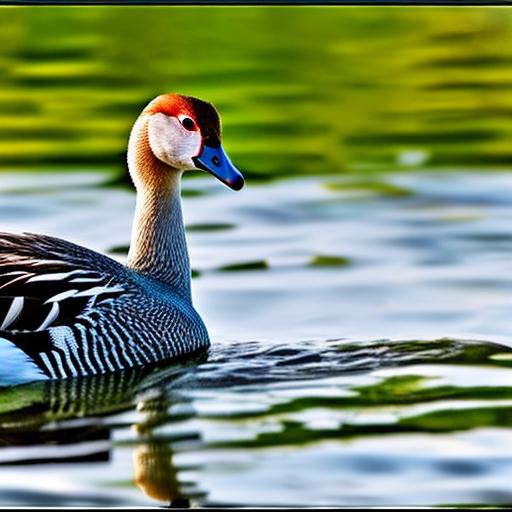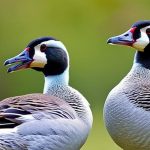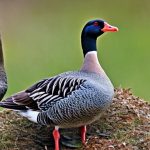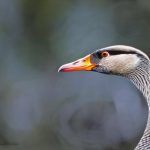Geese are known for their strong migratory instincts and their tendency to return to the same nesting and feeding grounds year after year. They are social birds that often travel in flocks and are highly adaptable to various environments. Geese are also known for their aggressive behavior, especially during nesting season when they are protecting their young. Understanding the behavior of geese is crucial in developing effective strategies for managing their presence in certain areas. By understanding their habits, such as their feeding and nesting patterns, it becomes easier to implement measures that will deter them from congregating in unwanted areas.
Geese are herbivores and are attracted to areas with abundant grass and water sources. They are also drawn to open spaces where they can easily spot potential predators. Geese are also known to be territorial and will aggressively defend their nesting sites from perceived threats. By understanding these behaviors, property owners can take proactive measures to discourage geese from settling in certain areas, such as implementing physical barriers or using deterrents to make the area less appealing to them.
Key Takeaways
- Geese are attracted to open areas near water and are known to be territorial and protective of their nesting sites.
- Physical barriers such as fences, netting, and hedges can effectively prevent geese from accessing certain areas.
- Deterrents like sound machines, predator decoys, and reflective objects can discourage geese from landing and nesting in specific locations.
- Creating an alternative landing area with tall grass or shrubs can redirect geese away from unwanted areas.
- Regular maintenance and cleaning of the area can help deter geese by removing food sources and making the area less attractive for nesting.
- Seeking professional help from wildlife management experts can provide effective and humane solutions for managing geese.
- It is important to respect wildlife regulations and seek proper permits before implementing any geese management strategies.
Implementing physical barriers
One effective way to manage the presence of geese in a specific area is by implementing physical barriers that prevent them from accessing the space. This can include installing fences, netting, or other structures that create a physical barrier between the geese and the area they are trying to access. Fences can be particularly effective in preventing geese from entering certain areas, especially if they are installed at a height that prevents the birds from flying over them.
Netting can also be used to cover bodies of water or other areas where geese may congregate, making it difficult for them to access these spaces. Physical barriers can be an effective long-term solution for managing geese, especially in areas where they pose a threat to human safety or property. By creating a physical barrier, property owners can effectively control the movement of geese and prevent them from settling in unwanted areas.
Using deterrents
In addition to physical barriers, using deterrents can also be an effective way to manage the presence of geese in certain areas. Deterrents are designed to make an area less appealing to geese, discouraging them from settling or congregating in that space. There are various types of deterrents available, including visual deterrents, auditory deterrents, and tactile deterrents.
Visual deterrents can include objects that move or reflect light, such as scarecrows or reflective tape, which can startle and deter geese from entering an area. Auditory deterrents can include devices that emit loud noises or distress calls of geese, which can make the area less appealing to them. Tactile deterrents can include physical objects that make it difficult for geese to access certain areas, such as spikes or other barriers that prevent them from landing or walking on surfaces.
Creating an alternative landing area
One proactive approach to managing the presence of geese is by creating an alternative landing area that is more appealing to them. By providing an alternative space for geese to land and congregate, property owners can effectively redirect their presence away from unwanted areas. This can be achieved by creating a designated area with suitable habitat features that attract geese, such as open grassy spaces near water sources.
By providing an alternative landing area, property owners can effectively manage the presence of geese in specific areas while also respecting the natural behaviors and needs of the birds. This approach can be particularly effective in areas where geese pose a threat to human safety or property, as it provides a proactive solution for managing their presence without causing harm to the birds.
Regular maintenance and cleaning
Regular maintenance and cleaning of outdoor spaces can also help manage the presence of geese in certain areas. Geese are attracted to areas with abundant grass and water sources, so keeping these areas well-maintained can discourage them from settling in unwanted spaces. This can include regular mowing of grassy areas, removing debris and litter from water sources, and keeping outdoor spaces clean and free of food sources that may attract geese.
By maintaining outdoor spaces and keeping them clean, property owners can effectively manage the presence of geese while also creating a more pleasant environment for human use. Regular maintenance and cleaning can also help prevent the buildup of waste and droppings left behind by geese, which can pose health risks and create unsightly conditions in outdoor spaces.
Seeking professional help

In some cases, managing the presence of geese may require professional assistance from wildlife management experts or pest control professionals. These professionals have the knowledge and experience to develop effective strategies for managing geese in specific areas while also ensuring compliance with wildlife regulations and ethical treatment of the birds. Professional help may be necessary in situations where geese pose a threat to human safety or property, or where their presence is causing significant damage to outdoor spaces.
Wildlife management experts can provide valuable insight into the behavior of geese and develop customized strategies for managing their presence in specific areas. Pest control professionals can also offer effective solutions for deterring geese and preventing them from settling in unwanted spaces. Seeking professional help is a proactive approach to managing the presence of geese while also ensuring that ethical and humane methods are used to address the issue.
Respecting wildlife regulations
When implementing strategies for managing the presence of geese, it is important to respect wildlife regulations and ensure compliance with local laws and ordinances. Geese are protected under various wildlife regulations, and it is important to consider these regulations when developing strategies for managing their presence in specific areas. This includes obtaining any necessary permits or approvals for implementing physical barriers or using deterrents that may impact the behavior of geese.
Respecting wildlife regulations also means considering the ethical treatment of geese and ensuring that any strategies implemented for managing their presence are humane and do not cause harm to the birds. It is important to work with wildlife management experts or pest control professionals who have knowledge of local wildlife regulations and can develop strategies that comply with these laws while effectively managing the presence of geese.
In conclusion, managing the presence of geese in outdoor spaces requires a proactive approach that considers the behavior of the birds, implements effective strategies such as physical barriers and deterrents, creates alternative landing areas, maintains outdoor spaces regularly, seeks professional help when necessary, and respects wildlife regulations. By understanding the behavior of geese and implementing appropriate measures, property owners can effectively manage their presence while also respecting their natural behaviors and needs.
If you’re tired of geese leaving a mess on your dock, you might be interested in learning about how to convert a shed into a chicken coop. This related article from Poultry Wizard provides valuable insights into creating a suitable environment for raising chickens, which can also help deter geese from loitering around your property. Check out the article here for practical tips on repurposing a shed to keep chickens and potentially keep geese at bay.
FAQs
What are some effective methods to keep geese from pooping on your dock?
Some effective methods to keep geese from pooping on your dock include installing bird deterrents such as bird spikes, using motion-activated sprinklers, applying non-toxic goose repellents, and using visual deterrents such as scarecrows or reflective tape.
Are there any natural ways to keep geese away from your dock?
Yes, there are natural ways to keep geese away from your dock. Planting tall grasses or shrubs near the water’s edge can create a natural barrier that discourages geese from coming onto your dock. Additionally, allowing natural predators such as dogs or hawks to roam the area can help deter geese.
Is it legal to harm or kill geese to keep them from pooping on your dock?
In many places, it is illegal to harm or kill geese as they are protected under wildlife conservation laws. It is important to explore non-lethal methods of deterring geese from your dock to avoid legal repercussions.
How can I clean up goose poop from my dock?
To clean up goose poop from your dock, you can use a hose to spray the affected area and then scrub it with a brush and soapy water. Alternatively, you can use a pressure washer to remove the poop. It is important to wear gloves and wash your hands thoroughly after cleaning up goose poop.
Meet Walter, the feathered-friend fanatic of Florida! Nestled in the sunshine state, Walter struts through life with his feathered companions, clucking his way to happiness. With a coop that’s fancier than a five-star hotel, he’s the Don Juan of the chicken world. When he’s not teaching his hens to do the cha-cha, you’ll find him in a heated debate with his prized rooster, Sir Clucks-a-Lot. Walter’s poultry passion is no yolk; he’s the sunny-side-up guy you never knew you needed in your flock of friends!







